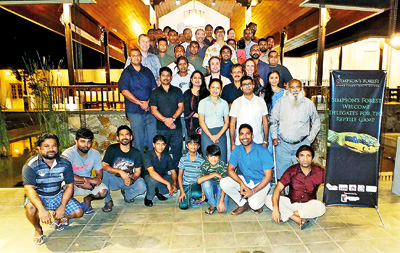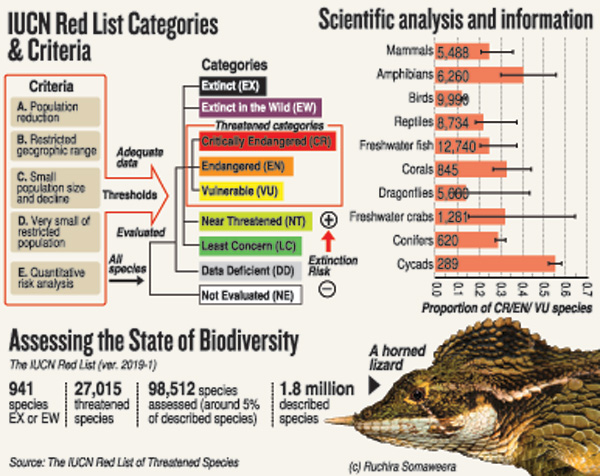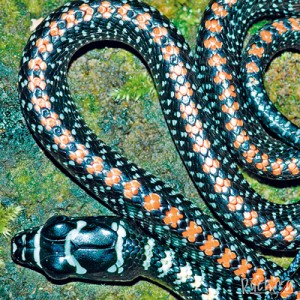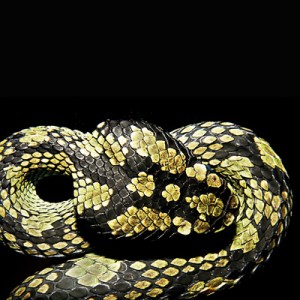News
Experts assess Sri Lankan species for Global Red List
Sri Lanka’s reptile experts gathered last week to assess the latest threat levels facing the country’s lizards and snakes.

The group of experts that participated at the recent workshop
During a six-day workshop at the Simpson’s Forest Hotel, they used some of the modern techniques to assess the threat levels these species have been exposed to, says Dr. Anslem de Silva, one of the organisers of the workshop, which also drew several foreign experts.
Sri Lanka is one of the global biodiversity hotspots (along with India’s Western Ghats), particularly for its high endemism of having creatures and plants that cannot be found anywhere else in the world.
But many of these species are threatened with extinction due to different reasons and the first step to protect them lies on understanding the threat levels to prioritise conservation actions.
The experts used the criteria accepted by the International Union of Conservation of Nature (IUCN) to assess the threat levels and list them in the IUCN Red List of Threatened Species. The list devised in 1964 is also known as the ‘Red List’.
The IUCN Red List classifies species into nine categories based on assessments such as the rate of decline, the population size and the area of distribution. On the IUCN Red List, the term “threatened” embraces the categories of Critically Endangered, Endangered, and Vulnerable. When no living trace can be found of a species, it is categorised as “extinct”.
While the global Red List explains the threat level on a global scale, most countries have their own Red Lists based on threat levels assessed nationally. Sri Lanka published its last National Red List on 2012, but the criteria used in assessing the threat levels were slightly different.
Technically, a standard assessment is required to go into the global red list.

Dr. Simon Stuart, the former Chair of the IUCN Species Survival Commission (SSC)

Dr. Anslem de Silva
However, during the workshop, the standard method was adopted to assess the threat levels Sri Lanka’s lizards and snakes faced, said Dr. de Silva, who was recently honored as ‘Father of modern herpetology’.
He organised the workshop with the assistance of Dr. Kanishka Ukuwela and Sameera Karunarathne. The assessment was driven by the Zoo Outreach Organisation and some of the world’s well-known scientists proficient in IUCN Red Listing. They included Dr. Sanjay Molur, Dr. Neil Ashley Cox, Marcelo Fabio Tognelli, Philip Michael Bowles and Claudine Gibson. The latter had specifically visited Sri Lanka for the assessment.
Almost all the Sri Lanka experts working on reptiles were present at this workshop. Speaking to the Sunday Times, herpetologist Mendis Wickremasinghe said this kind of assessment was important as there was an extinction crisis Sri Lanka’s reptiles faced. The checklist of reptiles consists of 155 species in 1993 but by 2012, it grew upto 211, with half of them endemic to Sri Lanka. It keeps on ticking. However, due to habitat loss and other key reasons, Sri Lanka’s reptiles are becoming rarer.
The final report being co-authored by all the resource persons will be an important document in conserving Sri Lanka’s reptiles, Dr. de Silva said.
The Sunday Times also learns that a similar red listing assessment had been completed for Sri Lanka’s freshwater fish. The freshwater fish study was conducted a few months ago by the IUCN country office.
IUCN Sri Lanka’s Senior programme officer (biodiversity) Sampath Goonatilake said the assessment would appear on the global red list web portal in December. “It is really important to update the threat levels of species as this is the global inventory for conservation actions,” he said.
Meanwhile, experts are also getting ready to conduct a similar assessment for Sri Lanka’s amphibians to update their status on the Global Red List of Threatened Species. This was revealed at a speech by Dr. Simon Stuart, the former Chair of the IUCN Species Survival Commission (SSC).
The speech was organised by Dilmah Conservation that is assisting the assessment process. The Sunday Times learns that the Amphibian Workshop will be held towards end of this year.
“The world’s species extinction crisis is getting worse. There are 1.8 million described species live on Earth and about 100,000 of them are assessed for the Red List. Of them, about 27,000 are threatened – this is closer to one third of the species – so the picture is not seemingly good,” Dr.Stuart said, pointing out that 941 species were already ‘extinct’ or ‘extinct in the wild’ — surviving only in captivity. “While we need to do more, if we stop conservation, this extinction crisis would be 7-8 times worse, the expert warned.
There were some conservation problems that we could not easily fix, but not all were negative, he said, giving examples where some species started to bounce back from the edge of extinction. Giant Pandas, Californian condors, Indian rhinos and Humb-back whales are few of such examples.
Sri Lanka produced a number of country-specific national red lists, with the last red list being published in 2012. The next one is scheduled to be published after five years.
Sri Lanka’s Biodiversity Secretariat Chief Padma Abeykoon said they would be able to publish the flora section of the Red List assessing national threat levels of plants, herbs and trees. She said that due to a number of issues, the fauna section would not be able to completed this year.

Beautiful colouration: Ornate flying snake and green pit viper. Pic by Ruchira Somaweera


